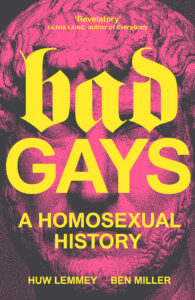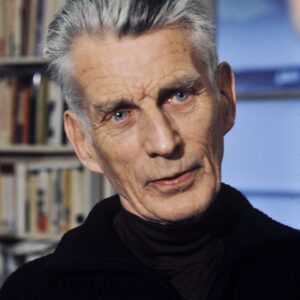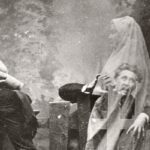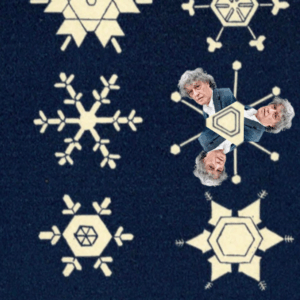
Why the “Bad Gays” of History Deserve More Attention
And What they Can Teach Us About Liberation
In 1891, Oscar Wilde’s star was on the rise. For a decade he had been the talk of London, a literary wit who pioneered the fashion and philosophy of aestheticism. He had successfully published works of prose and collections of poetry, and was preparing his first novel, The Picture of Dorian Gray, for publication, a masterful account of a Faustian bargain dripping with desire, vanity, and corruption. England regarded this sparkling Irishman with a combination of fascination, admiration, and horror, but no one could deny he was becoming a titan of the national culture.
Yet within five years, Wilde’s reputation, and his health, were destroyed. Sentenced to two years of backbreaking hard labor, Wilde was spat at by strangers as he was transported via train to jail. Upon release, he fled into exile, living in penury under an assumed name. Nobody wanted to be known as his friend. Less than a decade after he had reached the heights of literary stardom, Wilde was dead.
It’s right and proper that we remember the role Wilde played within an otherwise staid and repressive Victorian culture, as well as the important, pioneering work he did describing, in public, a form of same-sex desire that otherwise lay hidden and criminalized on the margins. Wilde was one of the first men in British society to give a creative form to a sexuality that barely yet understood itself, let alone was understood or discussed by straight people. For that, conservative forces succeeded in destroying him. But at the core of Wilde’s story is his love for a terrible young man, a love that drove him close to madness and sparked the wildfire of events that led to his ruin.
That boy, a petulant and cruel son of the British aristocracy, was Lord Alfred Douglas, known by his affectionate nickname “Bosie.” Wilde and Bosie first met in 1891, when Bosie was a 21-year-old undergraduate at Wilde’s alma mater, Magdalen College, Oxford. Bosie was an archetypal twink, popular and athletic, who cared more about his writing and activities in the new “Uranian poetry” movement, which idolized pederastic relationships between older and younger men, than his studies, which he never completed. In Wilde he found his ideal older lover and benefactor, whose work and plays he had already praised in Uranian journals.
Their tempestuous affair pushed Wilde’s homosexuality from the realm of flirtatious literary innuendo into that of reckless public identity. Besotted with the young poet, Wilde fell in with Bosie’s lifestyle and indulged his demands. The two lovers drank and partied together and became the subject of scurrilous rumors. They began to host wild sex parties with young working-class men, who they paid to fuck (or get fucked by). Wilde’s public image—an educated and charming raconteur, married with children—clashed with his private life, and while the conflict could hold for a few years, it wasn’t long before the inevitable happened. Wilde was expecting it. In a letter to Bosie after his release from jail, he wrote:
It was like feasting with panthers. The danger was half the excitement. I used to feel as the snake-charmer must feel when he lures the cobra. They were to me the brightest of gilded snakes. Their poison was part of their perfection.
After clashing with Bosie’s father, the Marquess of Queensberry, Wilde was left a calling card from the Marquess accusing him of being a sodomite. Queensberry, having two homosexual sons whom he regarded as having been corrupted by “snob queers” such as Wilde and then-prime minister Archibald Primrose, 5th Earl of Rosebery, was obsessed with homosexuality. Wilde’s friends told him to leave the case well alone, but, pushed by an impetuous and jealous Bosie, who hated his father, Wilde sued.
There was a fatal hole in Wilde’s case—he was a sodomite, and Queensberry could prove it. The civil trial not only humiliated Wilde in the eyes of a homophobic Victorian public, but instigated a further criminal trial for gross indecency. Wilde was found guilty and sentenced to hard labor, which, in the end, indirectly killed him.
Bad Gays is a book about the gay people in history who do not flatter us, and whom we cannot make into heroes.
Wilde’s imprisonment, as awful and scandalous as it was, came at what was both a dangerous and an auspicious time for the new figure of the “homosexual” in Europe. Within certain, albeit small, literary and scientific circles, a new identity was forming. Sexologists described a “third sex” somewhere between male and female. In cities thronging with the new proletarian masses and enriched by colonial plunder, a group of people became the first generation of activists pursuing something we might recognize as “gay rights.” They discussed same-sex desire with sensitivity, even respect, calling themselves “Uranians,” “Urnings,” or even “Homosexuals.”
For such people, Wilde’s trial was an important moment in the development of what would, in the ensuing decades, become something like a coherent movement. Scandals, after all, brought public attention. The newspapers wrote about the dangerous homosexuals, and more people began to recognize themselves as such and be endangered, and intrigued, by what that recognition might mean.
Wilde’s utopian vision of love between men remains, in Britain and beyond, a creation myth of the public male homosexual identity. Speaking at his trial Wilde launched a passionate defense of homosexual desire:
It is in this century misunderstood, so much misunderstood that it may be described as “the love that dare not speak its name,” and on that account of it I am placed where I am now. It is beautiful, it is fine, it is the noblest form of affection. There is nothing unnatural about it.
Such a statement can almost be seen as a rallying cry for the century of LGBTQ rights activism that was to follow, and Wilde became one of its first martyrs.
Bosie became a footnote in the story: an embodiment of “evil twink energy,” a poisoned apple whose path through life left a wake of destruction that led to the great hero’s downfall. Yet Bosie—the man, his desires, his attitudes, and his foibles—was just as integral to the eruption of homosexuality into the public sphere as was Wilde. Bosie set the trial in motion. Indeed, it was actually Bosie, and not Wilde, who had coined the term “the love that dare not speak its name” in one of his poems. No less than Wilde, Bosie shaped and was shaped by the sexual attitudes and cultures of his time, and Bosie’s later life of far-right political involvement is just as unpleasant and illuminating as his years with Oscar.
After Wilde’s death, Bosie—the subject of a biography by Douglas Murray—married a bisexual poet named Olive Custance, and when their marriage went downhill he converted to Catholicism and began espousing increasingly anti-Semitic views. He wrote articles for the anti-Semitic magazine Vigilante accusing various people of plots to undermine British masculinity with Jewish homosexuality, and in 1920 co-founded a magazine called Plain English that advertised copies of the anti-Semitic conspiracy theory The Protocols of the Elders of Zion, defamed leftists and the Irish, and accused figures as right-wing and conventionally masculine as Winston Churchill of being involved in Jewish conspiracies to undermine the war effort. (Churchill eventually sued, and won). After a period of imprisonment, Bosie died poor and obscure in 1945. Only two people attended his funeral.
For years, gay people have remembered Oscar as one of their own, but neglected Bosie as someone who has anything to tell us about how homosexuality came to be. Why do we choose to remember the witty and glamorous Wilde, and to forget the Machiavellian, anti-Semitic, and louche Bosie? And more crucially, why do we assume that Wilde’s life and attitudes shaped the track record of the project of homosexuality better than Bosie’s? Bosie was hardly the first gay to become obsessed with far-right and racist politics, or to confuse liberation with the freedom to live out his own desires and elevated class status.
Bad Gays is a book about such characters, a book about the gay people in history who do not flatter us, and whom we cannot make into heroes: the liars, the powerful, the criminal, and the successful. From Alexander the Great to J. Edgar Hoover, our history is littered with them. Unlike our heroes, however—people like Oscar Wilde, Audre Lorde, and Alan Turing—we rarely remember them as gay. And yet their sexuality was just as important an influence on their lives as those whom we celebrate, and their stories have much to tell us about how the sexual identities we understand today came to exist.
Over the course of our book, we profile these evil and complicated queers from our history. Among their ranks are emperors and criminals, fascist thugs and famous artists, austere puritans and debauched bon viveurs, yet all of them have one thing in common—they engaged in same-sex behavior that, in the context of today’s society, we might understand as, somehow, gay. By examining the interplay of their lives and their sexualities, this book investigates the failure of homosexuality as an identity and a political project.
“Failure” seems like a harsh word, and this assessment, while our primary argument, is of course incomplete. There is indeed hope for queer forms, and our history contains many vital, living histories of struggle, alliance, and solidarity. We think it’s important to think a bit about how these histories—and the darker stories we spend our book retelling—might exist in productive tension as we think about the future of gay lives in Europe and the United States.
The failure of mainstream, actually existing white male homosexuality to enact liberation and its embrace instead of full integration into the burning house of the couple-form, the family unit, and what we might hopefully call late-stage capitalism is real, and it is arranged on three primary axes: first, its separation from and fear of gender non-conformity; second, its simultaneous appropriation of the bodies and sexualities of racialized people and denial of those people’s full humanity, political participation, and equality; and third, its incessant focus on the bourgeois project of “sexuality” itself.
The first theme is explored in the scholarly work of people like Susan Stryker, who have pointed out that homosexuality’s project of self-justification has often depended on claiming normalcy at the expense of a gender non-conforming Other: the trans woman, the street queen, the person not respectable enough to “pass.”
The second is examined by people like C. Riley Snorton, Jules Gill-Peterson, and Ann Stoler, who have described the ways that the bodies of racialized and colonized people and ideas about their social organization have served as the literal substance of white metropolitan homosexual and transgender subjectivities and identities.
And the third has been discussed by a variety of queer Marxist scholars, from several generations of gay and queer activists themselves, to classic texts by activist-intellectuals like John D’Emilio on the emergence of gay identity and its relationship to capitalism, to Roderick Ferguson’s decrial of “one-dimensional” queer activism, to Christopher Chitty’s recent intervention into the correspondence between crises of capitalism and the persecution of poor and working-class sodomites. Our book aims to explore these themes not through scholarly argument, but through storytelling: by retelling the stories of a set of queer lives that are individually fascinating and horrifying, and that collectively communicate a version—our version—of the story of the evolution and failure of white male homosexual identities.
It can be very easy to assume that the way we think about identities has always been the same. Our race, gender, sexual orientation, or nationality can seem like such an important, intrinsic part of ourselves that we assume they must have been important for people living in the past as well. But identities are, as Stryker has said, “where the rubber of larger social and cultural systems hits the road of lived experience.” They are constantly changing and being changed by the shifting structural realities of life, by systems of production and exchange, by the ways that we relate to one another.
Even the idea that people have a specific “sexuality” is remarkably recent—perhaps only 150 years old, emerging out of the rapidly industrializing colonial metropolises of Europe. The rigid segmentation of time into separated zones of work and leisure, along with moral panics about “backwards” people intended to justify colonial expansion and incursions into the supposedly immoral private lives of the working classes, inculcated the idea that who you fucked made you who you were. Even after the invention of “homosexuality” (and “heterosexuality”) in the late 19th century, most people who felt same-sex love and desire did not want to convert their feelings into identities, to subscribe to being medicalized and set apart.
These feelings were, instead, sources of shame, crimes for which they could be punished, and social taboos. As some people began to fight for their recognition and against medicalizing systems, movements began to emerge. The people who led these movements—at least, the ones that have succeeded in winning state recognition—were often not working-class or people of color, but instead members of the emerging bourgeoisie who sought to assign positive values to their sexual acts within the prevailing value systems of their time. And often to bad ends.
At the same time, working-class people, colonized people, and people of color have consistently lived, fought for, manifested, and expressed forms of social and sexual expression that have challenged both social prejudice towards sexual and gender minorities and the bourgeois politics of the gay elite. These challenges have often been bitterly resisted by that elite in their time, while still—owing to their embrace of mass politics and disruptive organizing—having far-reaching effects in our queer lives.
Often, after the fact, the queer elite will belatedly acknowledge these people, movements, moments, and struggles in an attempt to incorporate them into the dominant story of what it means to be gay or lesbian or trans, as though the working-class gays and sex workers, drag queens, and trans women of color at the Stonewall Inn in New York City’s West Village threw bricks at cops in order to win marriage equality for the gay and lesbian donor class.
It is this process of struggle and contestation that has created the very idea of what being gay or queer is—it has marked the production of queer cultures, the discussion of queer lives, and queer people’s search for historical examples to justify their own acts and identities. Even the term “gay” has changed; 50 years ago, the term had a broader meaning that included queer and bisexual people, transgender people, transvestites, and more: anyone who lived openly outside the heterosexual and cissexist norms of a more conservative society and suffered as a result. Today, it tends to refer to a more limited idea of same-gender sexual attraction. These definitions, too, are sites of struggle and negotiation.
It can be difficult, therefore, to find the right terminology to discuss people who might fit into such a category today, when such ideas and identities did not exist in their society. Can you call someone like James VI and I, a man who almost certainly had sex with other men, a homosexual, when that identity did not even exist as a concept at the time? When he was ruling England and Scotland, and beginning his campaigns of colonization in Ireland and America, nobody thought who they fucked had anything to do with who they were. So what does it mean to call James, or the Emperor Hadrian, or any number of nefarious nellies from history, “gay?”
We have decided to use that present-day term as a way of putting today’s homosexuality under a microscope and figuring out why it is troubled and incomplete, and why it failed to live up to its utopian promises of liberation. By discussing these people and their shared behaviors in relation to each other, we can begin to draw out characteristics and stories that might shed a light on how a contemporary gay identity came to exist—from ideas of what it means to be “a man,” to how same-sex desire has influenced major historical events, to how the dreaded heterosexuals came to exist, to understand themselves as opposed to queers, and to fear, police, and repress us. Our subjects may not have held a “gay” identity, but their lives can tell us so much about why we do.
We want to dance through homosexuality’s usable and abusable pasts.
If “gay” is an imprecise term of convenience, so is “bad.” While some of the folks in the book are, without doubt, bad—fascists, murderers, and other such scumbags—many are a bit more complicated. We can start to look at their lives in the context of the times in which they lived, and see how, within that context, their decisions influenced or were influenced by their sex lives. Many were profoundly traumatized by the guilt they felt as a result of their sexual desires: pushed by society into lives they found themselves unable to lead, they made strange choices, or ended up damaging the world in their efforts to reform it.
Nonetheless, the links between their negative actions and their sexual desires are worth exploring, worth expanding upon. For example: can we really understand Roy Cohn’s aggressive political witch-hunting and fear of secret subversion outside the context of his own negative feelings regarding his homosexuality? It’s for these reasons we use the categories of “bad” and “gay”—as provocations to talk more deeply about what we understand both words to mean.
If it is not clear enough that we are not writing as homophobes, ask our boyfriends, our lovers, our friends. Both of us are deeply shaped by homosexuality but also deeply unsatisfied by it. This is why we have subtitled our book “A Homosexual History,” and we mean that precisely: not (just) that we are homosexuals or that our book is (only) a history of homosexuality or homosexual behaviors, but that we want to dance through homosexuality’s usable and abusable pasts. We learn from the broad spectrum of theory and activism by and about queer and trans people, and write from our position as white gay men, about a series of people whose behaviors, attitudes, and actions can help us understand why and how white male homosexuality, as a political, identitarian, and emancipatory project, has failed.
__________________________________

Excerpt from Bad Gays: A Homosexual History by Huw Lemmey and Ben Miller, published by Verso Books. Copyright © Huw Lemmey, Ben Miller 2022.
Huw Lemmey and Ben Miller
Huw Lemmey is a novelist, artist and critic. He is the author of three novels: Unknown Language, Red Tory, and Chubz. He has written for the Guardian, Frieze, Flash Art, Tribune, the Architectural Review, Art Monthly, New Humanist, the White Review, and L’Uomo Vogue, amongst others. As an artist and filmmaker, his work has been shown at the ICA, Lux Biennial of Moving Image, Mumok Vienna, Warsaw Museum of Contemporary Art and the Design Museum, London.
Ben Miller is a writer and researcher living in Berlin, where he is currently a Doctoral Fellow at the Graduate School of Global Intellectual History at the Freie Universität. He has written for the New York Times, Literary Hub, the Los Angeles Review of Books, and Tin House, and is the author of The New Queer Photography. He is a member of the board of the Schwules Museum, a queer museum and archive.



















